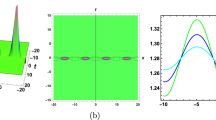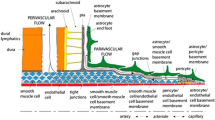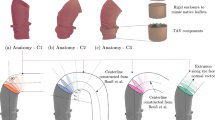Abstract
Based on earlier theoretical studies, a new mathematical model is developed for the prediction of the pressure and flow pulses propagating in the arterial system. This model permits a more realistic simulation of bifurcation and stenoses than was possible previously. By making use of a computer, it allows us to calculate the pulse shapes along branching arteries. It is based on the assumption that each arterial conduit can be represented by a suitable combination of three basic segments, namely segments with no or only small-calibre side branches, short segments with big side branches, and short segments with pathological changes of the conduit. Along segments of the first type, the pulse propagation is calculated with the aid of the method of characteristics and a first order integration. For the other two types, the linearized mass balance and momentum equations are utilized together with the boundary conditions to determine the pressure and flow values at the ends of the segment. A standard case for the human arterial conduit extending from the heart to the foot, with eight major branches, is defined using published data and prescribing the ejection pattern from the heart. The computed pulse shapes and their changes with propagation exhibit the characteristic features observed in man under normal conditions.
Similar content being viewed by others
References
Anliker, M., M. Casty, P. Friedli, R. Kubli, and H. Keller, Noninvasive measurement of blood flow. In:Cardiovascular Flow Dynamics and Measurements, edited by N.H.C. Hwang and N.A. Normann, Baltimore, MD: University Park Press, 1977.
Anliker, M., M.B. Histand, and E. Ogden. Dispersion and attenuation of small pressure waves in the canine aorta.Circ. Res. 23:539, 1968.
Anliker, M., R.L. Rockwell, and E. Ogden. Nonlinear analysis of flow pulses and shock waves in arteries. Part I: Derivation and properties of mathematical model. Part II: Parametric study related to clinical problems.J. Appl. Math. Phys. (ZAMP). 22:217–246 (Part I), 563–581 (Part II), 1971.
Anliker, M., J.C. Stettler, P. Niederer, and R. Holenstein. Prediction of shape changes of propagating flow and pressure pulses in human arteries. In:The Arterial System, edited by R.D. Bauer and R. Busse. Heidelberg: Springer, 1978.
Back, L., J. Radbill, and D. Crawford. Analysis of pulsatile, viscous blood flow through diseased coronary arteries of man.J. Biomech. 10:339, 1977.
Bennett, C.O., and J.E. MyresMomentum, Heat and Mass Transfer, 2nd ed., Chemical Eng. Ser., New York: McGraw-Hill, 1974.
Bollinger, A.Funktionelle Angiologie, Stuttgart: Thieme, 1979.
Casty, M. Perkutane atraumatische Flussmessung in grösseren hautnahen Gefässen mit einem vielkanaligen gepulsten Ultraschall-Dopplergerat Dissertation. University of Zurich, 1976.
Clark, M.E. and R.H. Kufahl. Simulation of the cerebral macrocirculation. In:Cardiovascular System Dynamics, edited by J. Baan and A. Noordergraaf. Boston: MIT Press, 1978.
Elsner, J. Mathematische Modellstudien der Druck-und Flusspulse in menschlichen Arterien. Dissertation No.5582. Swiss Federal Institute of Technology, Zurich, Switzerland, 1975.
Forbes, L.K. A note on the solution of the one-dimensional unsteady equations of arterial blood flow by the method of characteristics.J. Aust. Math. Soc. 21:45–52, 1979.
Holenstein, R., P. Niederer, and J.C. Stettler. A structural damping model of arterial viscoelasticity in predicting flow and pressure pulses. In: Conference Digest, 1st International Conference on Mechanics in Medicine and Biology. Baden-Baden: Verlag Gerhard Witzstrock, 1978.
Holenstein, R., P. Niederer, and M. Anliker. A viscoelastic model for use in predicting arterial pulse waves.ASME J. Biomech. Eng. 102:318–319, 1980.
Hübscher, W. and M. Anliker, Instantane Flussmessungen in grossen Blutgefässen mittles 128-kanaligem Ultraschall-Doppler-Gerät und Mikroprozessor.Medita. 9a/1977.
Hughes, T. and J. Lubliner. On the one-dimensional theory of blood flow in larger vessels.Math. Biosci. 18:161, 1973.
Lister, M. The numerical solution of hyperbolic differential equations by the method of characteristics. In:Mathematics for Digital Computers, New York: J. Wiley & Sons 1960.
McDonald, R.Blood Flow in Arteries, 2nd ed. London: Arnold 1974.
Prandtl, L.F▀rer durch die Strömungslehre, 3rd ed. Braunschweig 1948, p. 159.
Raines, J., M. Jaffrin, and A.H. Shapiro. A computer simulation of arterial dynamics in the human leg.J. Biomech. 7:77, 1974.
Rockwell, R.L., M. Anliker, and J. Elsner. Model studies of the pressure and flow pulses in a viscoelastic arterial conduit.J. Franklin Inst. 297:405 1974.
Rudinger, G., Shock waves in mathematical models of the aorta.J. Appl. Mech. 37:34, 1970.
Rumberger, J.A. and R.M. Nerem. A method-of-characteristic calculation of coronary blood flow.J. Fluid. Mech. 182:429, 1977.
Schaaf, B.W. and P.H. Abbrecht, Digital computer simulation of human systemic arterial pulse. wave transmission: A nonlinear model.J. Biomech. 5:345, 1972.
Stettler, J.C. Theoretische Untersuchungen der arteriellen Hämodynamik unter Berücksichtigung von Verzweigungen. Dissertation. Swiss Federal Institute of Technology, Zurich, Switzerland, 1979.
Streeter, V.L., W.R. Keitzer, and D.F. Bohr. Pulsatile pressure and flow through distensible vessels.Circ. Res. 13:3, 1963.
Westerhof, N., F. Bosmann, C.J. DeVries, and A. Noordergraaf. Analog studies of the human systemic arterial tree.J. Biomech. 2:121–143, 1969.
Wetterer, E. and Th. Kenner,Dynamik des Arterienpulses. Springer, 1968.
Witzig, K. Ueber die Wellenbewegung zäher Flüssigkeiten in elastischen Röhren. Dissertation. University of Bern, 1914.
Womersley, J.R. An elastic tube theory of pulse transmission and oscillatory flow in mammalian arteries. WADC Tech. Rep. TR 56-614, 1957.
Zielke, W. Frequency-dependent friction in transient pipe flow.ASME J. Basic Eng. 90: Series D, No. 1, 109, 1968.
Author information
Authors and Affiliations
Additional information
This work was supported in part by Grant 3. 121.–0.77 from the Swiss National Science Foundation.
Rights and permissions
About this article
Cite this article
Stettler, J.C., Niederer, P. & Anliker, M. Theoretical analysis of arterial hemodynamics including the influence of bifurcations. Ann Biomed Eng 9, 145–164 (1981). https://doi.org/10.1007/BF02363533
Issue Date:
DOI: https://doi.org/10.1007/BF02363533




